THE HORSES MUSCLES AND TISSUES
Horses are born with a certain amount of muscle fibers. Through exercise the horses’ abilities can be improved; this due to the fact that muscle fibers grow in thickness, but the number of muscle cells remains the same.
Connective tissue is the supporting tissue that keeps other types of soft tissue together. A strong connective tissue can prevent injuries in the muscles, tendons, and ligaments.
Bones are the living tissue; with exercise and training, it adapts itself to the shape of the leg and the quality needed for the work that is to be done. The ”training effect” therefore comes gradually compared to the training response of the muscles. For that reason, there is a reason that the skeleton does not catch up.
SKELETAL MUSCLES
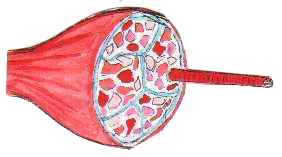
The skeletal muscles are the horses’ motor and the nutrients reach the muscles by the metabolism of blood circulation. Muscles build fuel for energy supply. The horses’ skeletal muscles are well developed and adapted to the energy supply. The skeletal muscles are also adapted for quick movement.
Muscles are composed of muscle fibers and connective tissue. The part of the muscle that contains the muscle fibers is called the capsule. The form of the capsule depends on how the muscle fibers are attached to the tendons at the edges of the muscle fiber and at the tissue inside the muscle. The capsule is surrounded by connective tissue (fascia) and even inside the muscle there are longitudinal connective tissue around each individual muscle fiber, as well as coarser connective tissue around groups of muscle fibers to prevent the muscle from getting stretched out. The muscle strength depends on how many parallel muscle fibers it contains and how coarse they are.
The strength of the muscle contraction is decided by, other than the amount of activated motor units, impulse frequencies, muscle fiber length, and speed of movement.
BLOODCIRCULATION OF MUSCLES
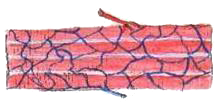
The blood circulation is the organisms transport system. It is responsible for making sure muscles get nutrients in the form of oxygen, glucose, fatty acids, amino acids, vitamins and minerals. The arteries are the blood vessels that transport the oxygen rich blood into the body. Veins are the blood vessels that transport waste products to specified areas and then continue to the lungs to pick up oxygenated blood.
The capillaries build a mesh network from the blood vessels to surroundings. Through the thin walls of the capillaries, exchanges of nutrients and waste products occur between the blood and fluid of the tissues. The exchange occurs in the space between the muscle fibers. From the capillaries, the blood returns through the veins.
NERVOUS SYSTEM
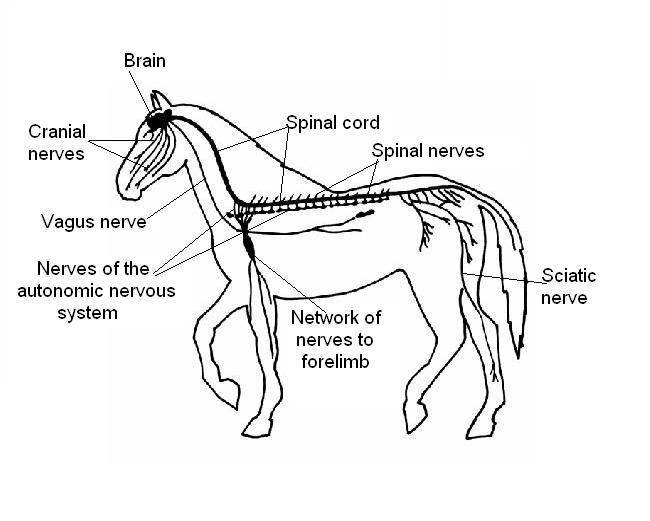
The striated muscle fiber contraction is usually initiated through nerve impulses. A nerve can give orders through its branches to up to two thousand muscle fibers that are spread through the same muscle.
The nervous system decides the motor units activation, the synergist and antagonist muscles interaction. Muscle training means that the horse is training to use the different muscles in the most effective way. The striated muscles are usually subject to conscious control.
ENERGY SUPPLY OF MUSCLES
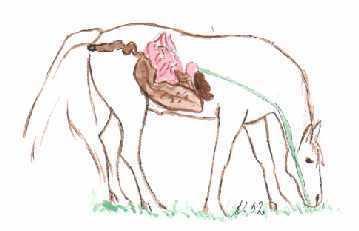
The skeletal muscles are the horses’ motor and the nutrients reach the muscles by the metabolism of blood circulation. Muscles build fuel for energy supply.
The skeletal muscles are the horses’ motor and the nutrients reach the muscles by the metabolism of blood circulation. Muscles build fuel for energy supply. The horses’ skeletal muscles are well developed and adapted to the energy supply. The skeletal muscles are also adapted for quick movement.
In cases of long term physical work the muscle is forced to extract energy from nutrients in the blood that is composed of fatty acids and glucose. At maximum work, the muscle uses its own supply of glycose: the form that is used to store glucose long term. Glucose from glycogen can be used in two ways: with oxygen (anaerobic glycose) a total breakdown occurs to water and carbon dioxide, where a lot of ATP (adenosine triphosphate) can be formed.
Glucose can also be broken down without oxygen (anaerobic glycose) where lactic acid is formed along with some ATP.
At maximal muscle effort, one to two minutes, or at high increased speeds, energy is obtained through anaerobic separation of glycogen where lactic acid is produced as a bi product.
With a well-trained horse, only some lactic acid is produced at exertion and in that way does not have a toxic effect. The lactic acid is transported to the liver where it is transformed back to glucose in a series of chemical steps, and is then used as an energy source. The lactic acid is also neutralized through breathing.
With the help of anaerobic glycose), the body is compromising oxygen since a well-trained horse only takes a few breaths under the last part of a race, even if a lot of energy is being used. After a race, a horse breathes heavily for a few minutes to regain a good oxygen level; the lactic acid is metabolized and stored energy is used to neutralize the lactic acid from the blood and muscles
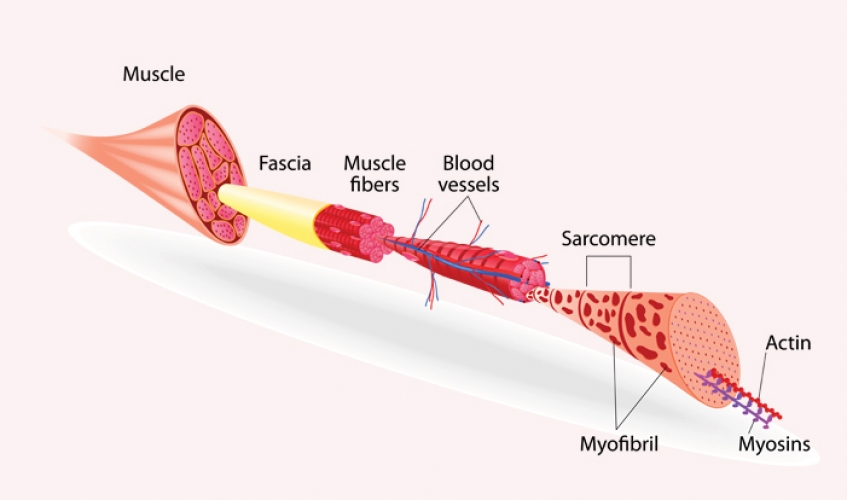
TYPES OF MUSCLE FIBERS
In one muscle there are three different types of skeletal muscle fiber types in a horse. Since the muscle fibers are not attached to each other, it is the connective tissue that prevents the muscle and muscle fibers from being stretched out.
Type I fibers-slow and persistent
These fibers perform slow work under a long period of time without fatiguing the muscle. In the slow muscle fibers, glucose and fat is broken down to form energy in the presence of oxygen.
Waste products that are produced are carbon dioxide and water.
Distance riders and horses that carry heavy loads at lower speeds use this type of muscle fiber and the process is aerobic, it uses oxygen the entire time.
Type IIA-fibers are quick and enduring
These fibers have developed specially for the horse to give speed and endurance. Type IIA fibers break down glucose to energy in the presence of oxygen. Waste products that are produced are carbon dioxide and water.
With the right type of exercise this type of fiber will increase in quantity up until about the age of four. In the best horse types, a large amount of type IIA fibers are found in the muscle mass and they increase specifically in trotters and racehorses, where aerobic work occurs.
Sample text. Click to select the text box. Click again or double click to start editing the text.
Type IIB fibers-very quick and easily fatigued
These fibers are large and quick, and produce energy without the presence of oxygen. Breakdown of glucose without oxygen gives lactic acid as a product. This builds up in the muscle, which means that it quickly fatigues when working.
A foal is born with a large amount of type IIB fibers to be able to move quickly and escape potential danger together with the mare. When the young horse is placed in training, the IIB fibers are transformed to mostly type IIA fibers.
Competition horses within trot and gallop use type IIB fibers at the home stretch when they are making the last attempt to reach the goal (anaerobic work).
A well-trained horse uses few breaths under this period even though the energy consumption is large and it gets a shortage of oxygen. After the race the horse breathes heavily for a while; it uses oxygen to neutralize the shortage.
Jumping, dressage, and eventing horses require training to be planned so that they can develop the muscle type that is needed for their type of work.
CONNECTIVE TISSUE
Connective tissue has a well-expanded blood circulation. Capillaries, the smallest blood vessels, build a tight mesh network in the connective tissue. Most muscle fibers are found near a capillary. Type I and IIA fibers have a high oxidation capacity and are the muscle fibers that have contact with many capillaries compared to type IIB that often come in contact with few capillaries.
The capillary network is build into the connective tissue when a horse trains regularly. The capillaries exert oxygenated blood to the muscle fibers and draw out waste products like lactic acid and carbon dioxide from the soft tissue to the cleansing organs like the liver and kidneys.
If a horse is to reach a good performance level, the muscles need to adapt to a state that gives a high type of IIA/IIB quote: a lot of capillaries and a high oxidative capacity.
The Horses' Mentality
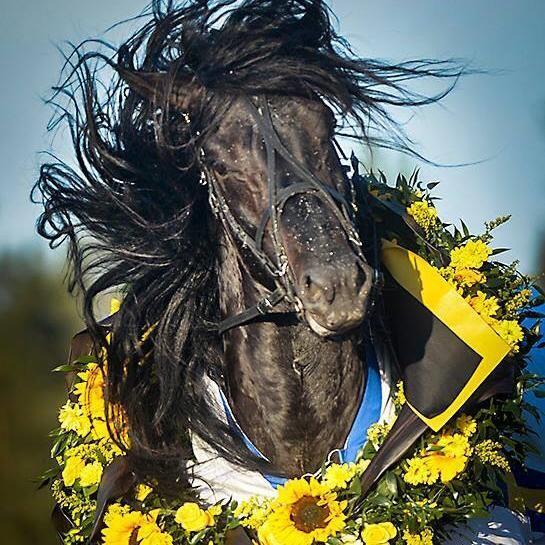
Månprinsen, Swedish Cold Blood. If a horse has all the presumptions to become a star but not the right mentality, it will not perform well on the track.
LUNG CAPACITY, HEART CAPACITY, AND OXYGENATION
The lung-size a horse has when it has reached adulthood is the size that it retains all of its life. The lungs can never be trained to increase in size or to take in more air. The lungs develop with the horses’ age.
The horse is born with a limit for maximum heart frequency and it cannot be raised through training. When a horse is trained, it heart becomes stronger, more sustainable, and effective in pumping blood.
The ability to take up oxygen, or the amount of oxygen in the inhaled air that can be taken in, can be improved through training. This occurs through training of the respiratory muscles and an increase in the number of red blood cells that transport oxygen in the blood.
THE MENTAL CAPACITY
If a horse has all the presumptions to become a star but not the right mentality, it will not perform well on the track.
The different sensory organs collect and pass on information to the nervous system about what is occurring around the horse and how it’s experiencing its surroundings. The mental capacity comprises the horses’ ability to adapt to its environment.
The horse is a flight animal and all individuals have different abilities to handle stress.
The horses senses and tolerance for stress is strongly affected by events in its surroundings, like being moved between tracks. Of course a horse gets to know its owner, trainer, coachman, and equestrian as well.
THERE IS AN UNDERLYING THOUGHT WITH THE RECOMMENDED PRODUCTS
We recommend
FERRUM for oxygenation of the muscle fibers and removal of lactic acid,
MAKROMIN for supporting nerve impulses for the working muscle fibers of rhythmic movements,
VITOSYL-E to help expand the capillary network around the muscle fibers, and
MINESYL as the base feed.